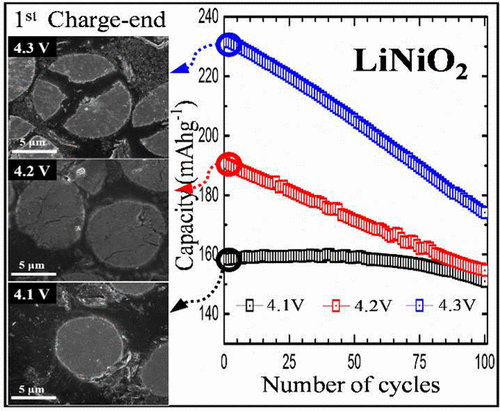当前位置:
X-MOL 学术
›
ACS Energy Lett.
›
论文详情
Our official English website, www.x-mol.net, welcomes your
feedback! (Note: you will need to create a separate account there.)
Structural Stability of LiNiO2 Cycled above 4.2 V
ACS Energy Letters ( IF 19.3 ) Pub Date : 2017-04-26 00:00:00 , DOI: 10.1021/acsenergylett.7b00304 Chong S. Yoon 1 , Do-Wook Jun 2 , Seung-Taek Myung 3 , Yang-Kook Sun 2
ACS Energy Letters ( IF 19.3 ) Pub Date : 2017-04-26 00:00:00 , DOI: 10.1021/acsenergylett.7b00304 Chong S. Yoon 1 , Do-Wook Jun 2 , Seung-Taek Myung 3 , Yang-Kook Sun 2
Affiliation

|
A spherical stoichiometric LiNiO2 particle, which was composed of compactly packed nanosized primary particles, was prepared and cycled at different cutoff voltages to explicitly demonstrate the effect of phase transitions during Li deintercalation/intercalation on the Li-ion intercalation stability of LiNiO2. The capacity retention was greatly improved by suppressing the H2 → H3 phase transition at 4.1 V, such that 95% of the initial capacity (164 mAh g–1) was retained after 100 cycles when cycled at 4.1 V. At 4.2 and 4.3 V, continuous capacity loss (81% of 191 mAh g–1 at 4.2 V and 75% of 232 mAh g–1 at 4.3 V after 100 cycles) was observed during cycling, and these electrodes incurred extensive structural damages (micro-, hairline and nanoscale cracks observed by transmission electron microscopy) from the repeated lattice contraction and expansion accompanying the H2 → H3 transition, in agreement with the cycling data.
中文翻译:

循环高于4.2 V的LiNiO 2的结构稳定性
制备了由紧密堆积的纳米级一次颗粒组成的球形化学计量LiNiO 2颗粒,并在不同的截止电压下循环,以明确证明Li脱嵌/嵌入过程中的相变对LiNiO 2的Li离子嵌入稳定性的影响。通过抑制4.1 V时的H2→H3相变,可以大大提高容量保持率,在4.1 V循环100次后,可以保留95%的初始容量(164 mAh g –1)。在4.2和4.3 V时,连续容量损失(在4.2 V时为191 mAh g –1的81%和232 mAh g –1的75% 在循环过程中观察到在100 V循环后在4.3 V下的电压),这些电极由于伴随H2→H3转变的重复晶格收缩和膨胀而遭受了广泛的结构破坏(通过透射电子显微镜观察到的微细线,细线和纳米级裂纹)。骑行数据。
更新日期:2017-04-26
中文翻译:

循环高于4.2 V的LiNiO 2的结构稳定性
制备了由紧密堆积的纳米级一次颗粒组成的球形化学计量LiNiO 2颗粒,并在不同的截止电压下循环,以明确证明Li脱嵌/嵌入过程中的相变对LiNiO 2的Li离子嵌入稳定性的影响。通过抑制4.1 V时的H2→H3相变,可以大大提高容量保持率,在4.1 V循环100次后,可以保留95%的初始容量(164 mAh g –1)。在4.2和4.3 V时,连续容量损失(在4.2 V时为191 mAh g –1的81%和232 mAh g –1的75% 在循环过程中观察到在100 V循环后在4.3 V下的电压),这些电极由于伴随H2→H3转变的重复晶格收缩和膨胀而遭受了广泛的结构破坏(通过透射电子显微镜观察到的微细线,细线和纳米级裂纹)。骑行数据。


















































 京公网安备 11010802027423号
京公网安备 11010802027423号